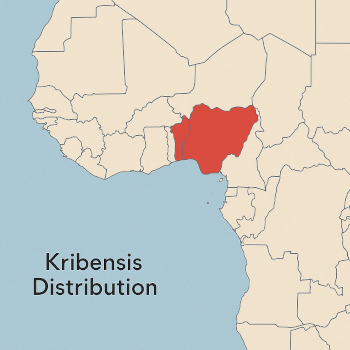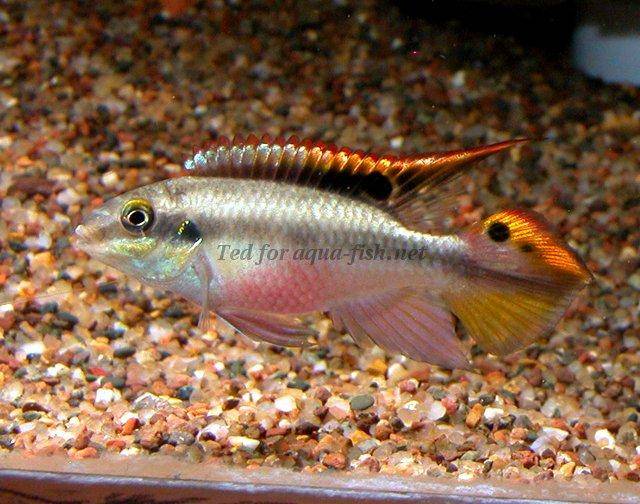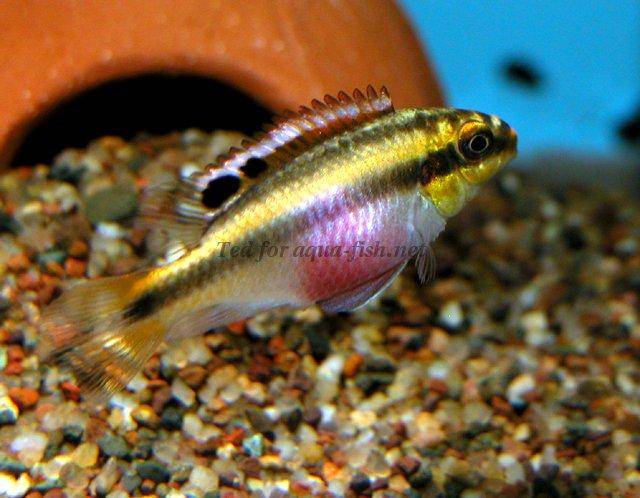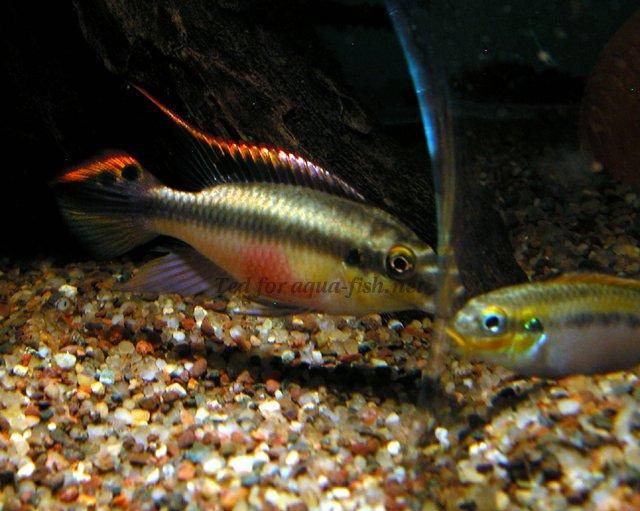Kribensis (Pelvicachromis pulcher) – Care, Diet, Tankmates & Breeding Tips



Quick Links
Brief Description
Kribensis (Pelvicachromis pulcher) are colorful and peaceful dwarf cichlids native to West Africa, ideal for community tanks and beginner breeding projects. This article covers their care, diet, ideal tank mates, and breeding behavior. You're welcome to share your experience or ask questions below.
Often recommended for beginner aquarists, Kribensis are prolific and resilient fish. When a compatible pair forms, breeding occurs readily, and one of the main challenges becomes managing the high number of fry. Their striking coloration, unique parental care, and peaceful nature make them a favorite among cichlid enthusiasts.
Though the name "Kribensis" was historically linked with Pelvicachromis taeniatus, it has become the widely accepted common name for Pelvicachromis pulcher. The name itself is derived from Latin: "pelva" (belly), "chromis" (color), and "pulcher" meaning beautiful — an apt description for this vividly colored species.
Size
Kribensis typically grow up to 4 inches (10 cm), classifying them as dwarf cichlids. They are well-suited for tanks as small as 20 gallons (90 liters), especially when intended for breeding. Commercial names include Niger cichlid, Purple cichlid, and Palette cichlid, with albino strains also available.
Origin
In the wild, Kribensis (Pelvicachromis pulcher) are native to the slow-moving rivers, streams, and floodplains of southern Nigeria and western Cameroon. These habitats are often shaded by overhanging vegetation and rich in leaf litter, creating soft, slightly acidic water conditions. Water levels and flow vary seasonally, especially during the rainy season when temporary flood zones provide ideal breeding grounds.
The substrate in these regions is typically sandy or muddy, with plenty of hiding spots formed by submerged roots, driftwood, and dense aquatic vegetation. Native plants such as Ceratophyllum demersum (Hornwort), Nymphaea lotus (Tiger Lotus), and Anubias species grow along the banks and in shallower waters, offering shelter and spawning areas.
Kribensis often coexist with other West African fish species, including small characins like Arnoldichthys spilopterus (African red-eyed tetra), Micralestes species, and other peaceful cichlids such as Hemichromis bimaculatus (Jewel cichlid) and Tilapia species. These fish communities are typically balanced and adapted to low to moderate water flow and a detritus-rich diet.
Although Kribensis can tolerate mildly brackish conditions near river mouths, they thrive best in freshwater environments with stable parameters. Their natural resilience to fluctuations in water chemistry makes them well-suited for home aquariums when mimicking their biotope.
Interestingly, females of this species are more vibrantly colored than males—a rare trait in the fish world. This sexual dimorphism is especially pronounced during courtship and spawning periods.
Tip for aquarists: To replicate their natural biotope in the aquarium, use fine sand substrate, add driftwood and caves, and plant hardy species such as Anubias, Java fern, and floating plants to provide shaded areas. Keep lighting subdued and maintain slightly acidic water for best coloration and breeding behavior.


Appearance & Water Conditions
Kribensis exhibit an olive body with a dark lateral stripe from eye to tail. Males develop pink bellies, while females boast vibrant red abdomens and sometimes greenish throat patches. Fins are dark with yellow-to-orange edging, becoming even more vivid during courtship.
These cichlids tolerate a wide range of water conditions, but optimal values are:
- pH: 6.5 – 7.5
- Temperature: 72 – 80°F (22 – 27°C)
- Soft to moderately hard water
A tank length of at least 24 inches (60 cm) is recommended. Add hiding places such as caves or clay pots, which also serve as ideal spawning sites. Regular water changes are essential for health and breeding success.
Diet
Kribensis are omnivores and not picky eaters. They readily accept:
- High-quality flake and micro granules
- Frozen and live foods: brine shrimp, mosquito larvae, daphnia
- Vegetables like blanched spinach, zucchini, or shelled peas
Offer protein-rich foods 2–3 times per week to enhance color, conditioning, and breeding readiness. Live or frozen food can also stimulate natural hunting instincts.
Suggested Weekly Feeding Schedule
| Day | Main Food | Supplement / Note |
|---|---|---|
| Monday | High-quality flake food | Optional: small amount of spinach or spirulina flake |
| Tuesday | Frozen brine shrimp | Enhances coloration and breeding activity |
| Wednesday | Micro granules or pellets | Ensure size fits their mouth |
| Thursday | Live mosquito larvae or daphnia | Natural protein boost |
| Friday | Flake food | Add finely chopped blanched zucchini |
| Saturday | Frozen or live brine shrimp | Great for conditioning before breeding |
| Sunday | Optional fasting day | Helps digestion and mimics natural cycles |
Tank Mates
Ideal companions include peaceful species of similar size, such as tetras, barbs, rasboras, and other dwarf cichlids. Avoid fish with long fins (e.g., Angelfish, Gouramis) due to potential fin-nipping. Small species like Guppies may be seen as prey, especially during breeding periods.


Breeding
Kribensis are monogamous and form pairs naturally when kept in groups. Once paired, they should be moved to a dedicated breeding tank. Caves, clay pots, and rock shelters provide excellent spawning sites. Spawning is discreet; the female may vanish for several days, during which the male patrols the tank.
Females lay 50–300 eggs on the roof of the spawning site while swimming upside-down. She guards the eggs, while the male defends the territory. Eggs hatch within 3–7 days. Parents transport the fry in their mouths to safe locations and guard them closely.
Fry can be fed crushed flake, baby brine shrimp, microworms, vinegar eels, or commercially available fry micro-pellets. Offer small portions multiple times a day. For best growth, live foods like newly hatched brine shrimp should be introduced early.
As the fry grow, introduce finely crushed granules and consider adding daphnia or live microfoods to encourage natural hunting behavior. A sponge filter is recommended in the breeding tank to avoid fry being sucked in and to provide biofilm as supplemental nutrition.
It's normal for first-time parents to eat initial batches of eggs while learning. Subsequent spawnings occur every 4–5 weeks, so consider moving fry to a separate rearing tank in time.
Watching Kribensis raise their young is both educational and rewarding. Their attentive parenting makes them excellent subjects for beginner breeders.
Frequently Asked Questions (FAQ)
- Are Kribensis suitable for beginners?
- Yes. They are hardy, easy to care for, and breed readily in home aquariums.
- Can Kribensis live in community tanks?
- Yes, but avoid housing them with long-finned or very small fish, especially during breeding periods.
- How do I tell males from females?
- Females tend to be more colorful with rounder bodies and bright red bellies. Males are larger with longer dorsal and anal fins.
- How often do Kribensis breed?
- They can spawn every 4–5 weeks if conditions are suitable and fry are removed in time.
- Do Kribensis need live food?
- Live food is not essential but is beneficial for conditioning before breeding. They will thrive on quality dry and frozen foods.
